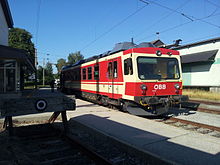ÖBB 4855
| ÖBB 4855 / Stern & Hafferl ET 25.103-104 | |
|---|---|
|
Stern & Hafferl 25.103
|
|
| Numbering: | ÖBB: 4855.001-002; Stern & Hafferl: 25.103–104 |
| Number: | 2 |
| Manufacturer: | Knot |
| Year of construction (s): | 1989 |
| Retirement: | 2017 |
| Gauge : | 1435 mm ( standard gauge ) |
| Length over buffers: | 24,400 mm |
| Length: | 23,100 mm |
| Height: | 3,980 mm |
| Width: | 2,850 mm |
| Empty mass: | 42 t |
| Service mass: | 58 t |
| Top speed: | 120 km / h / 60 km / h at 800V = |
| Hourly output : | 480 kW / 240 kW at 800V = |
| Power system : | 15 kV, 16.7 Hz ~ or 800 V = |
| Number of traction motors: | 2 |
| Drive: | Pawbearing drive |
| Brake: | Regenerative brake, compressed air brake |
| Train control : | PZB |
| Seats: | 64 |
| Standing room: | 62 |
| Floor height: | 1,220 mm |
The ÖBB purchased two class 4855 dual-system railcars for the Lambach – Haag am Hausruck local railway (Haager Lies) . The Stern & Hafferl Verkehrsgesellschaft was responsible for the management of the local railway . The two vehicles were used exclusively on the local railway until the Haager Lies was discontinued on December 13, 2009. When operations ended, the vehicles were returned to the owner ÖBB.
history
The two railcars of the 4855 series were procured when the ÖBB was considering either discontinuing the Haager Lies or converting it to diesel operation, as the locomotives had to use two different power systems. A large part of the route was electrified with 800 V direct current , the first kilometers that had to be driven on the Westbahn , however, with 15 kV / 16.7 Hz alternating current . That is why two multi-system vehicles were commissioned from Knotz. Because of the bankruptcy of this company, the two-system traction vehicles were delivered in 1989 by Bombardier - Rotax . The vehicles were included in the inventory as ÖBB 4855.001 and 002, the Stern & Hafferl Verkehrsgesellschaft referred to them as ET 25.103 and 104.
The vehicles exhibited good running characteristics and operational safety with short driving times. With them, continuous connections to Wels main station were realized, which resulted in an increase in the number of passengers. After the Haager Lies was discontinued, the railcars were returned to the ÖBB and adapted for the planned ÖBB operation in the Linz, Florisdorf and Vorchdorf workshops . Railcar 25.104 needed extensive repairs after a serious accident with a truck.
In order to stay close to the Vorchdorf workshop, where the skilled staff from Stern & Hafferl had serviced the vehicles for twenty years, the decision was made to use the Vöcklabruck – Kammer-Schörfling (Kammerer Bahn) railway in the future . Between summer 2013 and summer 2014 the railcars with the ÖBB logo were in use between Attnang-Puchheim or Vöcklabruck and Kammer-Schörfling . They had the ideal capacity for this relation, but the planned tandem tour in the morning school traffic could not be realized due to technical difficulties.
They have been parked at Linz Central Station since January 2016. On September 30, 2017, they were formally withdrawn and then released for scrapping.
construction
The one-piece, four-axle railcars are specially designed for one-man operation. The car body is designed as a self-supporting structure, which consists of hollow profiles. This is in turn covered with sheet steel. The two driver's cabs as well as pulling and pushing devices are attached to the ends of the vehicle; the passenger compartment is in the middle of the vehicle. All electrical equipment and a transformer are installed under the passenger compartment. The main frame and the box are supported on the two bogies . The railcars were painted in the typical Stern & Hafferl style: the box was painted red / cream, the drive and roof were given an umbra gray color scheme. During their deployment on the Haager Lies, they wore the Stern & Hafferl logo below the windshield , and the inscription “Lokalbahn Lambach - Haag” under the side windows.
technical features
The two single-arm pantographs , the braking resistors and the main switch are carried by the roof. The two mixer motors are supplied by an oil-cooled transformer with an integrated smoothing choke. In alternating current operation, the current is rectified. The drive system largely corresponds to that of the ÖBB 4020 series . The tensile force is transmitted to the box via the ball bearing cage. The gear ratio on the helical gear wheel is 1: 4.25. The vehicles have a block brake, an indirectly acting compressed air brake and a battery-excited regenerative brake. Each railcar is equipped with Sifa , Indusi as well as ÖBB and Stern & Hafferl train radio .
literature
- Klaus-J. Vetter: The great manual for electric locomotives . Sconto, Munich 2003, ISBN 3-7654-4066-3 .
Individual evidence
- ↑ a b c d e series 4855 retired in: Lok Magazin 2/2018, p. 72.
- ^ Row 4855 reactivated , Eisenbahn Österreich 4/2013, page 161.
- ↑ Locomotive statistics September 2017 , Eisenbahnverkehr aktuell 11/2017, page 534.



